In with the New

Montage co-owner Liz Cingari and her stepson, Erik Bates, have waited years for the modern revolution to take hold in Boston. / Photo by Jared Leeds
This city’s antiques shops used to thrive on the ambitions of an upwardly mobile class trying to replicate accepted standards of fine breeding and good taste—young professionals who filled their homes with period furniture, Oriental rugs, and crystal chandeliers. They’d spend crisp autumn weekends at auction houses or North Shore stores, hunting for a set of six Queen Anne chairs or a Victorian buffet that would work in the breakfast room. On Sunday evenings, returning from a fruitful outing, they might haul a Sheridan secretary out of the paneled wagon, or while the night away polishing watermarks off an American mahogany hunt table in the dining room. Some even turned their garages into amateur refinishing workshops. The link to history affirmed their station in the world. They followed the lead of the Brahmins, who had set the iconography of wealth and success in the region for centuries. “Antiques expressed that the homeowners had arrived, that they had substance behind them,” says the Cambridge antiques dealer and interior designer Heidi Pribell.
Old money, in other words, dominated the aesthetic here. Creaky and antique were highbrow, shiny and new were lowbrow. A beat-up Mercedes was more likely than a new one to signify a trust-funder with a museum wing named after his grandfather. You used inherited china and silver, because it would be wasteful to replace it (and if you hadn’t inherited these things, you pretended you had). Country clubs had parking lots full of jalopies with rotting sneakers and lacrosse sticks in the back seat.
It was a complete society based on not only money but also a reverence for the past, tradition, and a well-weathered look, not to mention a deep-rooted Puritan practicality. Sukey Forbes, of the Forbes family, says that as recently as the 1970s, her parents’ house in Milton was a study in shabby chic. But nobody ever thought about changing things. “You get married, receive a whole lot of hand-me-downs from different relatives, and then just live in that house, and you never really redecorate again,” she says. “Why would you buy a new one if the old one worked perfectly fine? I mean, that’s very much the kind of family that I grew up in. You know, the leg on the chair is broken, well duct tape, don’t—I mean, God, you bought a new chair? That’s crazy.”
Brahmin families like the Saltonstalls, the Forbeses, and the Endicotts preferred to hide, not flaunt, their wealth. “There was almost a level of embarrassment about having so much,” Sukey Forbes says. “Very often the richest person in the room was the one who looked the poorest. There was a great sense of reverse snobbery and pride in having things that were shabby.” You kept that piano you inherited from your great-grandmother years ago, no matter what state it was in. The reason, as Forbes’s cousin Beth Colt puts it, was simple. “It’s terribly out of tune, and nobody’s played it in 50 years, but it was Great-Grandmother’s, and she was an excellent player, and that’s why.”
Exclusivity, of course, was what gave that society such allure. If you were shut out, all you could do was try to adopt its look, manner, and styling, the better to impress others who’d been denied entry. Ralph Lauren nailed the aesthetic and built an empire in the ’80s simulating the look of old money. The Official Preppy Handbook (1980), written as a spoof, became a very serious primer for those new to the old-money game. Brands like J.Crew (1983) emerged, capitalizing on the “always been here” Brahmin mystique.
But Boston’s new power elite, part of the rising generation that has created the new economy, has now largely turned its back on all of that. Smart, driven, and plugged in, they strongly identify with the technology that made their wealth and lifestyle possible, and they want their homes to exude an innovative, worldly spirit. For them, says Ashley Mears, a sociologist at Boston University, “consuming a broad range of cultural goods is itself a mark of distinction.” In other words: They don’t care about history. They want a look that says new, not old.
“Everyone’s influenced by the branding of Apple,” says Heidi Pribell. “They want more Zen-like interiors. It’s the culture we’re living in.” Now anything that seems old-fashioned or archaic is out. “At one time, everyone wanted to have inherited items,” she continues. “Now it’s like, Ew, who wants to look like Grandma?”

Beacon Hill is the perfect place for contemporary living, say tech masterminds Jennifer Chayes and Christian Borgs, shown inside their gleaming white, gut-rehabbed townhouse. / Photo by Jared Leeds